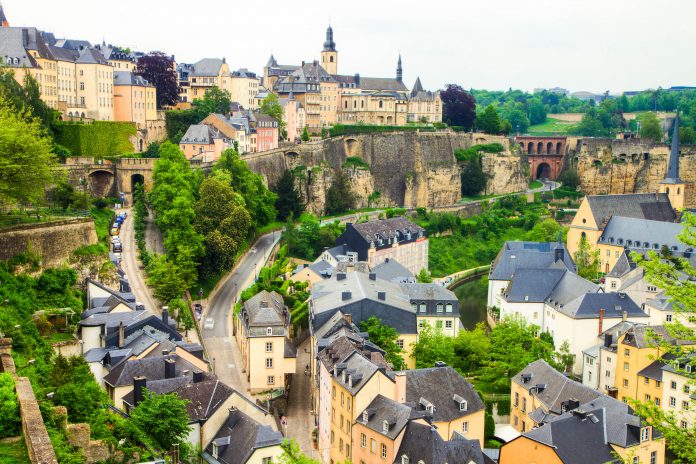Die verwinkelten Gässchen der malerischen Altstadt von Luxemburg können zu Fuß erkundet werden und bieten inmitten einer traumhaften Landschaft eine Vielzahl an historischen Häusern, imposanten Bauten und idyllischen Plätzen.
Die wunderschöne Altstadt von Luxemburg Stadt zählt seit 1994 zum Weltkulturerbe der UNESCO. Auch die Umgebung von Luxemburgs Hauptstadt hat einige Museen und zahlreiche architektonische Highlights zu bieten.
Vom markanten Bockfelsen, der die berühmten unterirdischen Gänge der „Kasematten“ als Überreste der einstigen Befestigung von Luxemburg Stadt beherbergt, sind es bis ins pittoreske Gassengewirr der Luxemburger Altstadt über die Montée de Clausen nur wenige Gehminuten.
Am Ende der Rue Sigefroi betritt man die entzückend schmale Rue de la Loge, in der ein Hauserker mit dem vielzitierten Luxemburger Motto „Mir welle bleiwe, wat mir sin“ („Wir wollen bleiben, was wir sind“) begrüßt.
Inhaltsverzeichnis
Fëschmaart (Fischmarkt)

Mittelpunkt der malerischen Altstadt von Luxemburg ist seit jeher der Fëschmaart, der historische Fischmarkt. Hier kreuzten sich einst zwei Römerstraßen und vor der Grafenburg wurden die ersten Märkte Luxemburgs abgehalten. Am Fischmarkt befindet sich heute neben dem Nationalmuseum für Kunst und Geschichte und der St. Michaels-Kirche auch das Gebäude des Staatsrates von Luxemburg.
Nationalmuseum von Luxemburg

Das Nationalmusée fir Geschicht a Konscht oder MNHA (Musée National d’Histoire et d’Art) zeigt Kunstwerke und Artefakte aus allen Epochen von Luxemburgs Vergangenheit, darunter Gemälde, Skulpturen, Münzen, Waffen, Rüstungen und eine 25.000 Bände umfassende Bibliothek.
Das Museum wurde im Jahr 1854 von der Société archéologique gegründet und wurde rasch zum Mittelpunkt der Luxemburger Museen. 1922 erhielt das Museum seinen Standort am Fischmarkt, der 2002 noch durch einen modernen Zubau vom Architekturbüro Christian Bauer et Associés erweitert wurde.
UNTERKÜNFTE & HOTELS: Luxemburg Stadt
St. Michaels-Kirche
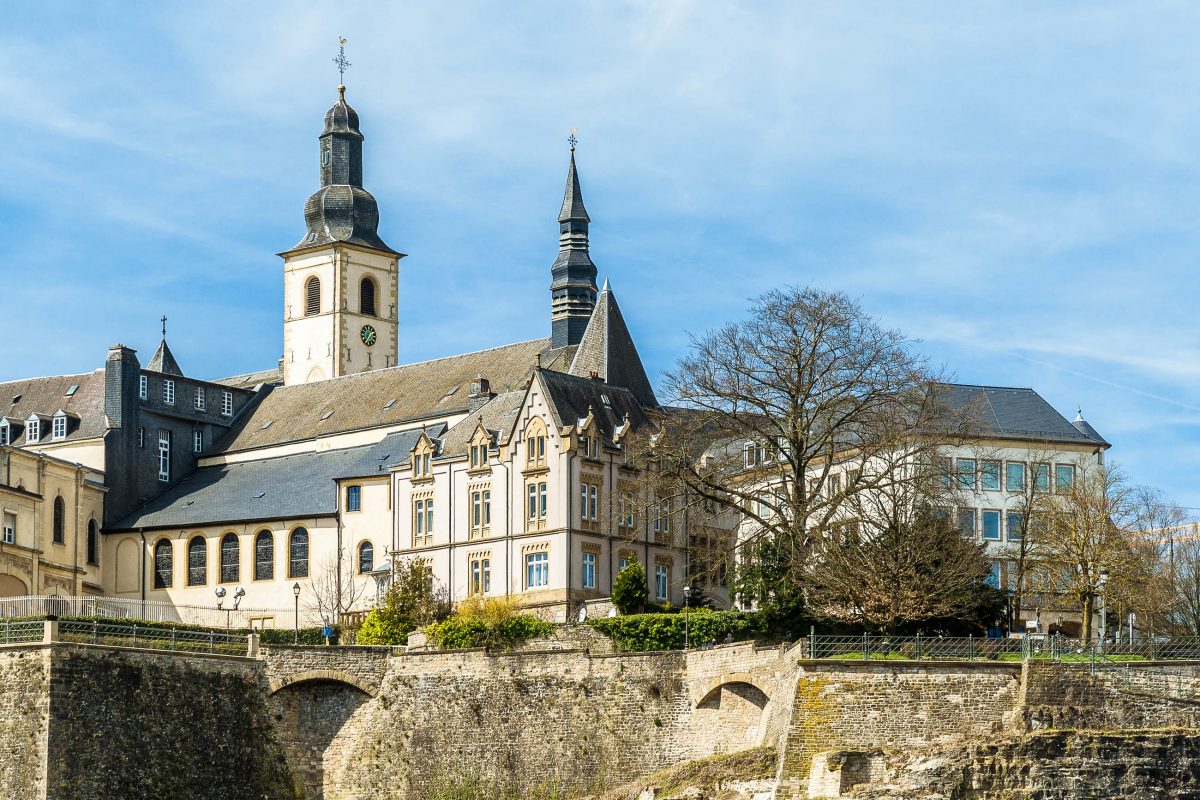
Die St. Michaels-Kirche ist die älteste Kirche von Luxemburg Stadt. Sie war ursprünglich die Burgkapelle der Grafen von Luxemburg, die 987 errichtet wurde. Der heutige Bau stammt aus dem Jahr 1688 und enthält romanische, gotische und barocke Stilelemente. Ihre gewaltige Orgel wurde 1959 zum „Monument historique“ erklärt.
Großherzoglicher Palast
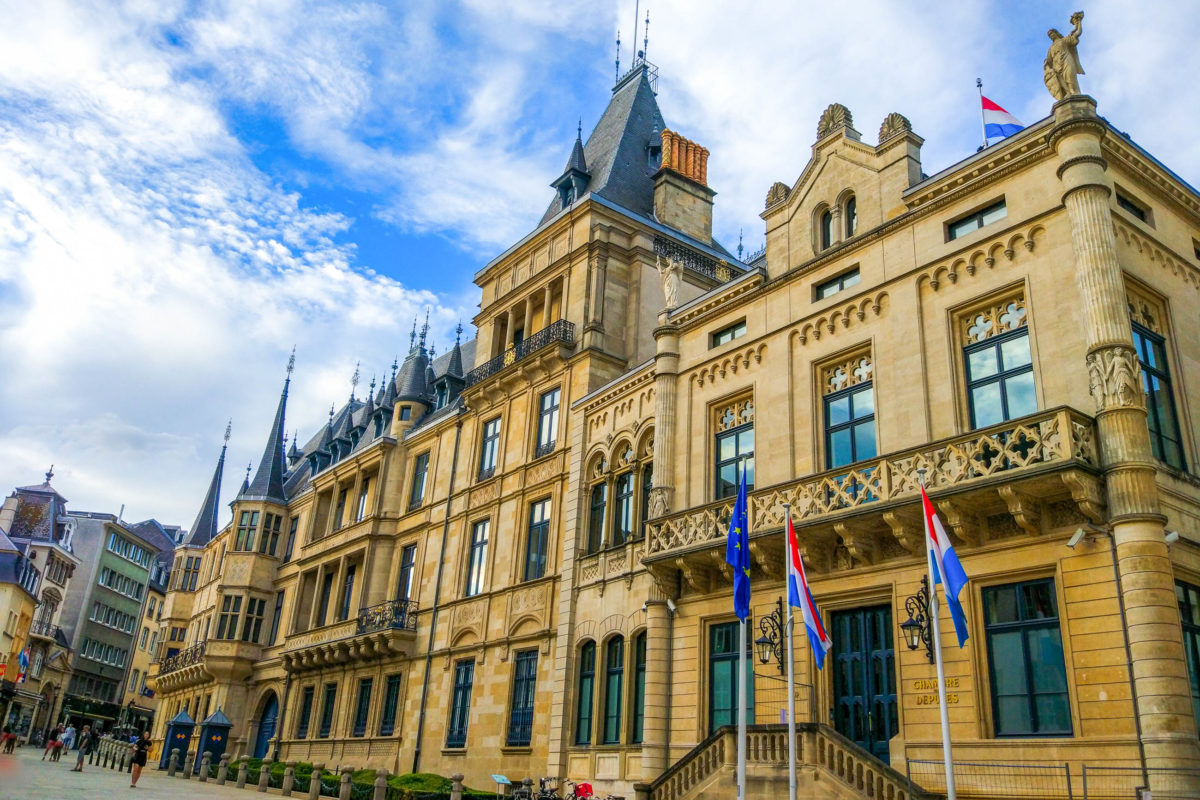
Gleich schräg gegenüber dem Nationalmuseum thront unübersehbar der Großherzogliche Palast von Luxemburg, der nahezu die gesamte Rue du Marché-aux-Herbes flankiert. Gleich rechts neben dem imposanten Palais befindet sich seit 1859 die luxemburgische Abgeordnetenkammer.
Früher stand hier das Rathaus von Luxemburg Stadt, das jedoch 1554 bei einer Pulverexplosion zerstört wurde. Der heutige Bau wurde noch bis 1817 als Rathaus genutzt, als erste Residenz diente er 1817 dem Repräsentanten des niederländischen König-Großherzoges in Luxemburg.
Heute wird der eindrucksvolle Palast vor allem für Staatsempfänge und als Bürogebäude für die Großherzogsfamilie und ihre Angestellten genutzt. Zu Weihnachten werden die Weihnachtswünsche des Großherzogs aus dem Gelben Raum an die Bevölkerung übermittelt.
Place Guillaume II (Knuedler)

Zwei Straßen westlich des Großherzoglichen Palais öffnet sich der weitläufige Place Guillaume II. Ein bronzenes Reiterstandbild erinnert an den einstigen Großherzog Wilhelm II, der von 1840 bis 1849 König der Niederlande und Großherzog von Luxemburg war.
Am Place Guillaume II findet jeden Mittwoch und Samstag der bunte Wochenmarkt statt, auf dessen Ständen frisches Obst und Gemüse, Fisch, Käse und Blumen angeboten werden. Weiters werden Freilichtkonzerte und Festivitäten, darunter das berühmte Rock-Festival „Rock um Knuedler“, am Place Guillaume II veranstaltet.
Rathaus von Luxemburg
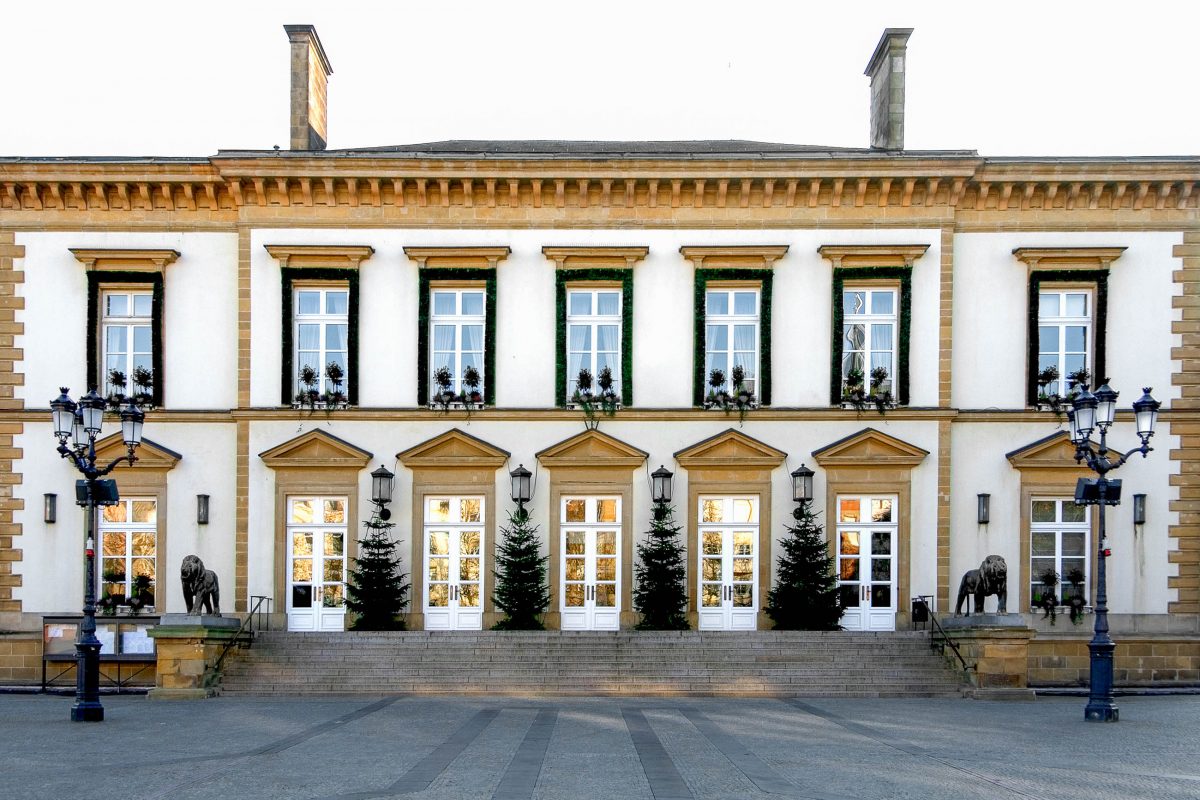
Am Südende des Place Guillaume II thront das „Hôtel de Ville“, das Rathaus von Luxemburg. Das neoklassizistische Gebäude wurde von 1830 bis 1838 zum Großteil aus Steinen des alten Franziskanerklosters erbaut.
1844 wurde das Rathaus in Luxemburg Stadt von Großherzog Wilhelm II. eingeweiht, nach dem Ende der Belgischen Revolution. Die beiden stolzen Bronze-Löwen, die die äußere Treppe des Rathauses flankieren, wurden im Jahr 1931 errichtet.
Warum heißt der Platz Knuedler?
Der Place Guillaume II wird von den Luxemburgern „Knuedler“ genannt. Dieser Spitzname rührt vom „Knued“, dem Knoten des Gürtels der Franziskaner-Mönche her, deren Kirche und Kloster sich seit dem 13. Jahrhundert auf dem Platz befanden.
Im Jahr 1797 allerdings wurde die Klosteranlage von den Franzosen beschlagnahmt und unter Napoleon in kleinen Stücken veräußert. In den folgenden Jahrzehnten wurde der Platz nach Plänen des belgischen Architekten Justin Remont völlig neu angelegt.
Place d’Armes
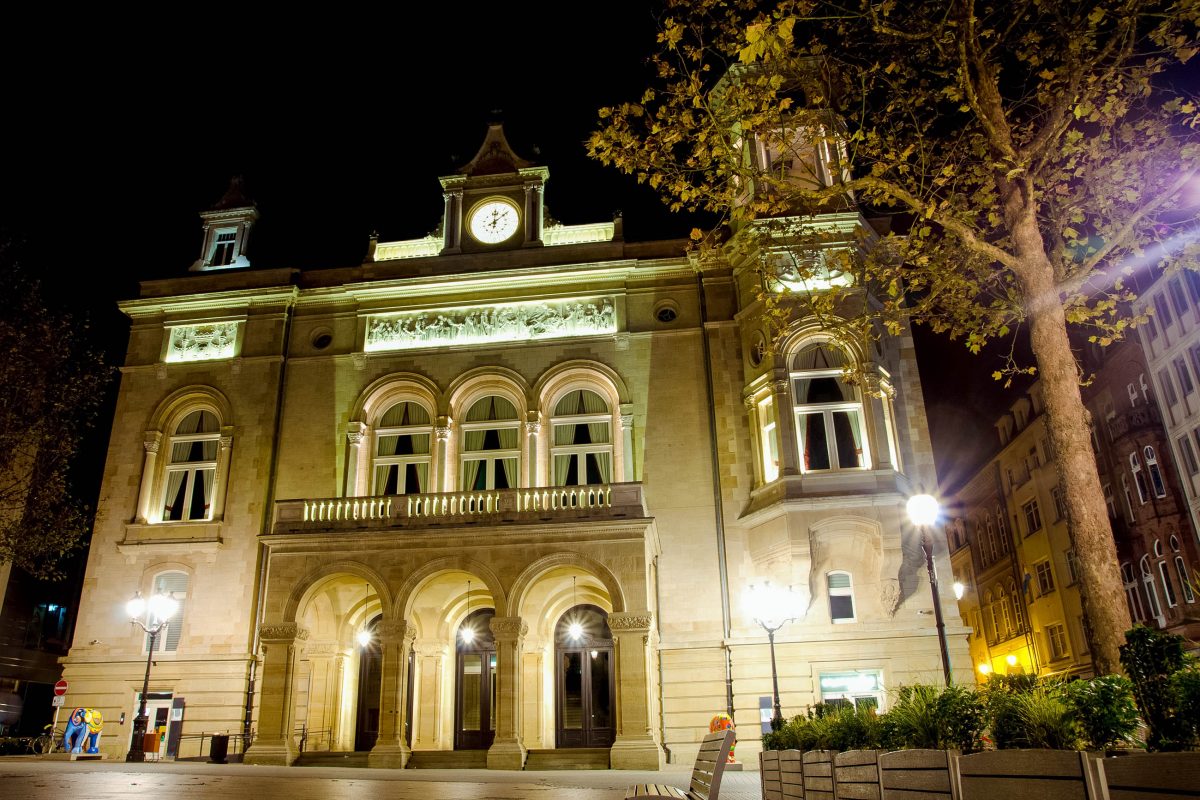
Schräg gegenüber dem Place Guillaume II liegt in der Fußgängerzone der Place d’Armes (Paradeplatz), an dem sich auch die Touristeninformation von Luxemburg Stadt befindet. Gemeinsam mit dem Knuedler bildet er das Zentrum von Luxemburgs Hauptstadt.
Der Place d’Armes ist mit seinen zahlreichen Straßencafés unter schattenspendenden Linden ein beliebter Treffpunkt. Im Sommer finden am Place d’Armes Konzerte statt, im Winter der Weihnachtsmarkt.
Dominiert wird der gemütliche Platz vom monumentalen Cercle Municipal aus dem Jahr 1909, der heute als Kulturzentrum fungiert.
Ebenfalls erwähnenswert ist das Dicks-Lentz-Denkmal am Westende des Place d’Armes. Pierre Federspiel feiert hier die beiden luxemburgischen Dichter Dicks (eigentlich Edmond de la Fontaine) und Michael Lentz aus dem 19. Jahrhundert. Auch hier ist das Motto der Luxemburger zu finden: Mir welle bleiwe, wat mir sin!
Kathedrale Notre Dame
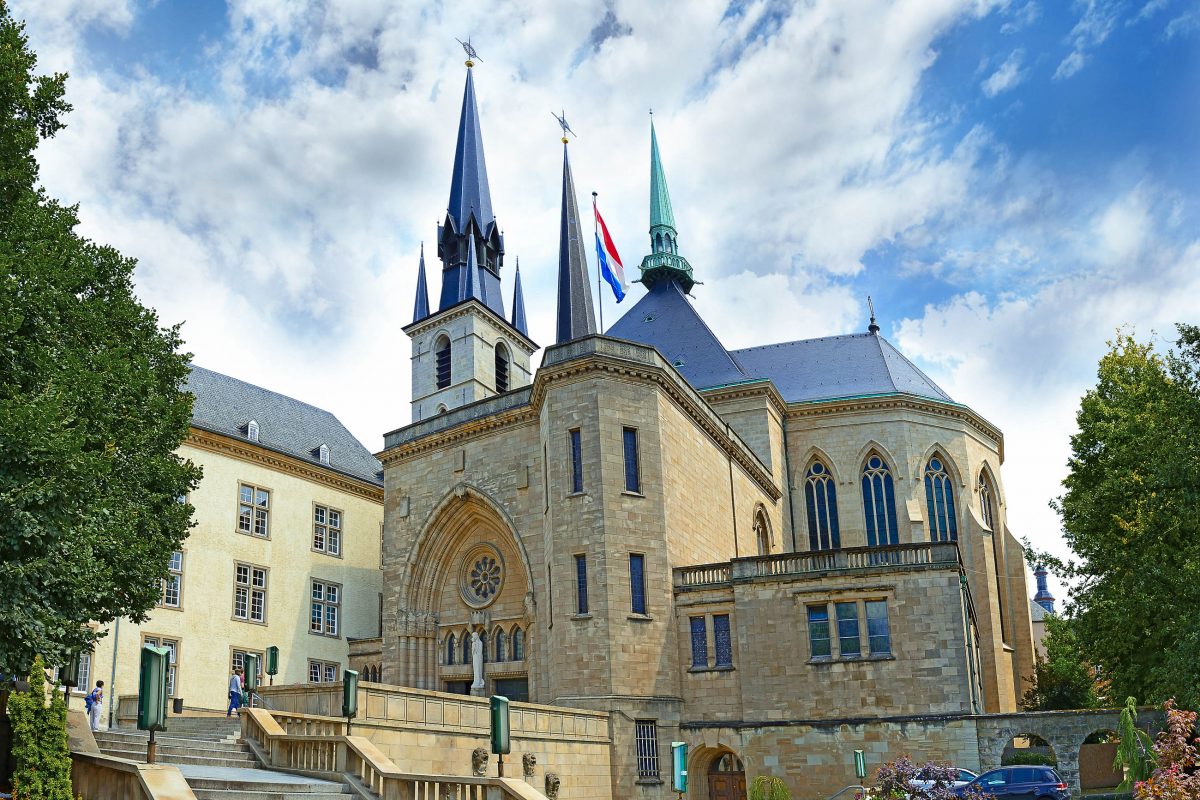
Spaziert man zwischen dem Place d’Armes und dem Place Guillaume II die Rue Chimay entlang gelangt man auf die Rue Notre Dame, benannt nach der Kathedrale Notre Dame. Das monumentale Gotteshaus ist die einzige Kathedrale in Luxemburg und wird auch als „Krone der Altstadt“ bezeichnet.
Die Kathedrale Notre Dame ist ein Meisterwerk der spätgotischen Architektur. In ihrem Inneren thronen ein prächtiger Hauptaltar und kunstvolle Alabaster-Figuren, die durch die farbigen Rundbogenfenster mystisch beleuchtet werden.
Geschichte der Kathedrale Note Dame
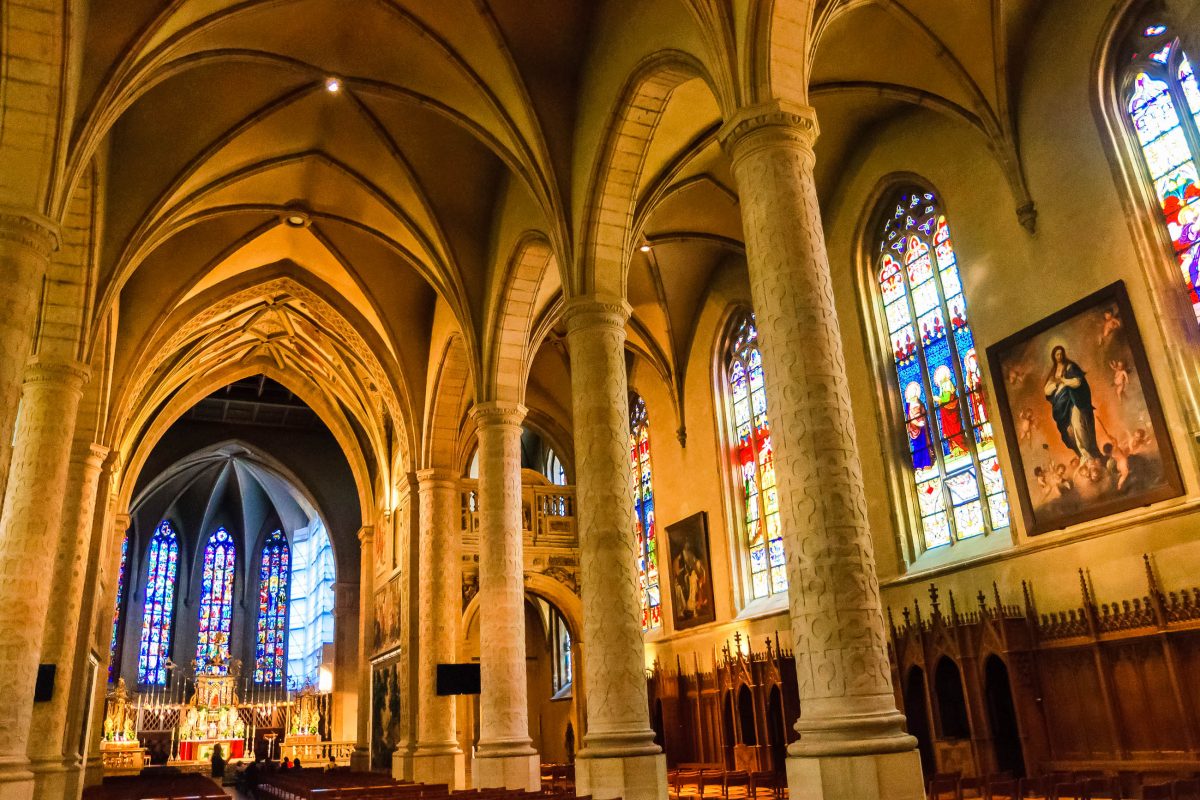
Die Ursprünge der Kathedrale gehen bis ins Jahr 1613 zurück, damals entstand in der Kathedrale Notre Dame eine Jesuitenkirche. Der Baumeister der Kirche war damals Ulrich Job aus Luzern.
Der Kern der heutigen Kathedrale, die auch Mariendom genannt wird, stammt aus dem 18. Jahrhundert. 1773, nachdem die Jesuiten Luxemburg verlassen hatten, stiftete Maria Theresia von Österreich die Kirche der Stadt. Damals wurde sie dem Heiligen Nikolaus und der Heiligen Theresa geweiht.
Seit 1848 heißt die Kirche Notre Dame. 1870 wurde sie von Papst Pius IX. zur Kathedrale ernannt. Die letzte Renovierung des Gotteshauses erfolgte in den 1930er-Jahren, im Zuge dessen sie auch großzügig erweitert wurde. Die Herausforderung, die Zubauten der Kathedrale harmonisch in die architektonische Umgebung einzufügen, hat der luxemburgische Architekt Hubert Schumacher hervorragend gemeistert.
Besuch der Kathedrale Notre Dame

Die Kathedrale Notre Dame ist ein Meisterwerk der spätgotischen Architektur, weist aber auch Elemente und Verzierungen aus der Renaissance auf. In ihrem Inneren thront ein prächtiger Hauptaltar mit einer vergoldeten Statue der Mutter Maria. Barocke Engel aus sanftweißem Alabaster, die im frühen 17. Jahrhundert vom Freiberger Künstler Daniel Müller geformt wurden, musizieren zwischen polierten Blättern und Blüten. Durch die farbigen Glasfenster erleuchtet das Sonnenlicht in sanften Strahlen den großzügigen Innenraum.
Die eindrucksvolle Orgel auf der Westempore stammt aus dem Jahr 1880 und wurde 1929 erweitert. Ihre satten Klänge können noch durch eine zweite, kleinere Orgel ergänzt werden.
Ebenfalls volle Töne erzeugen die 11 Glocken im Westturm der Kathedrale, der schon zur Jesuiten-Kirche gehörte. Der Ost- und der zentrale Kirchturm wurden erst im Zuge der Erweiterung in den 1930er-Jahren angefügt, wobei letzterer nur ein Drittel der Höhe der anderen beiden Türme aufragt.
In der Krypta der Kathedrale Notre Dame sind unter anderen berühmten Persönlichkeiten einige Großherzoginnen von Luxemburg bestattet.
Am anderen Ende der Kathedrale liegt der Place Clairefontaine, auf dem sich ein bronzenes Denkmal der Großherzogin Charlotte befindet.
Gëlle Fra (Goldene Dame)
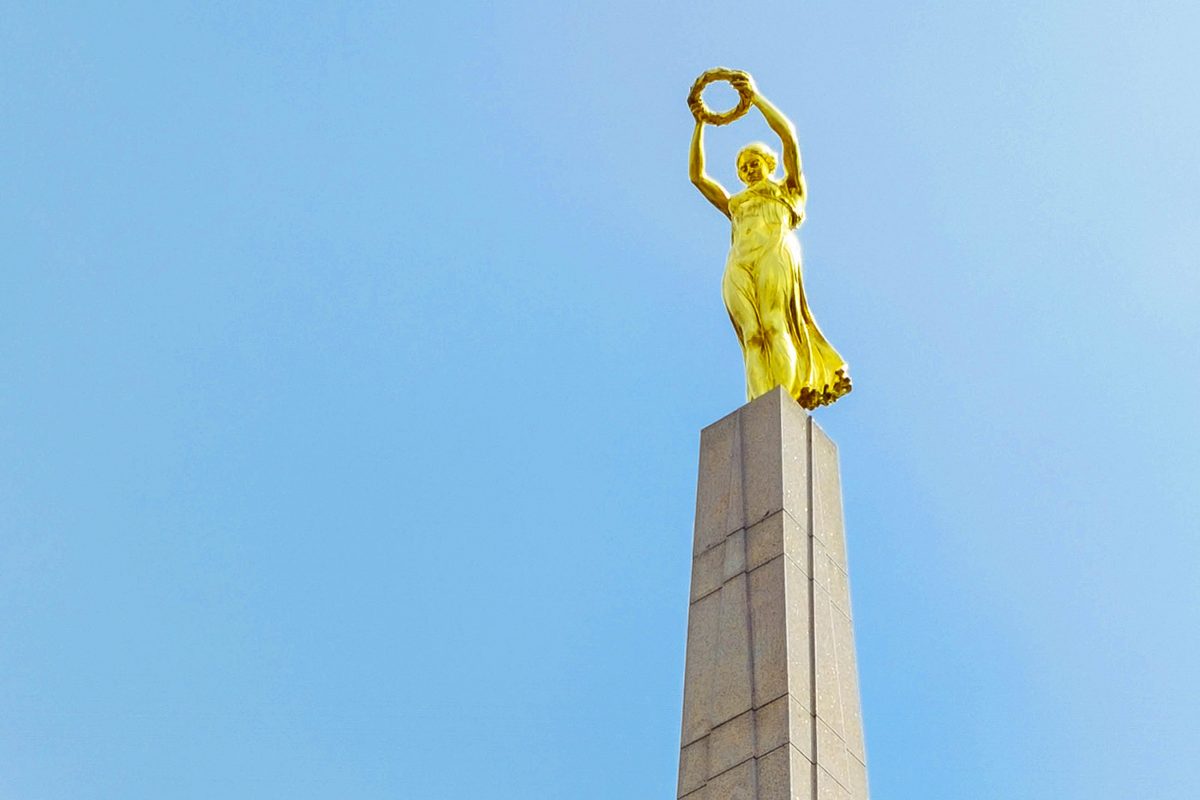
Von der Kathedrale in Richtung Süden gelangt man auf den großen F.D. Roosevelt-Boulevard und erblickt gleich rechter Hand den Place de la Constitution mit der Gëlle Fra.
Das Denkmal am Rande der Luxemburger Altstadt heißt eigentlich „Monument du Souvenir“ und erinnert an die gefallenen Soldaten des Ersten Weltkriegs. Schöpfer des Denkmals ist der luxemburgische Künstler Claus Cito, der das Monument im Jahr 1923 fertigstellte.
Die vergoldete Frauenstatue aus Bronze blickt mit einem Lorbeerkranz in den erhobenen Händen von einem 21m hohen Obelisken aus Granit auf die Straße hinab. Wer für die Figur Modell stand ist unbekannt. Tatsache ist jedoch, dass das Mahnmal bei seiner Enthüllung aufgrund der leichten Bekleidung der Gëlle Fra für Aufsehen sorgte. Die Kirche bezeichnete die Gëlle Fra sogar als „reinste Nudität“.
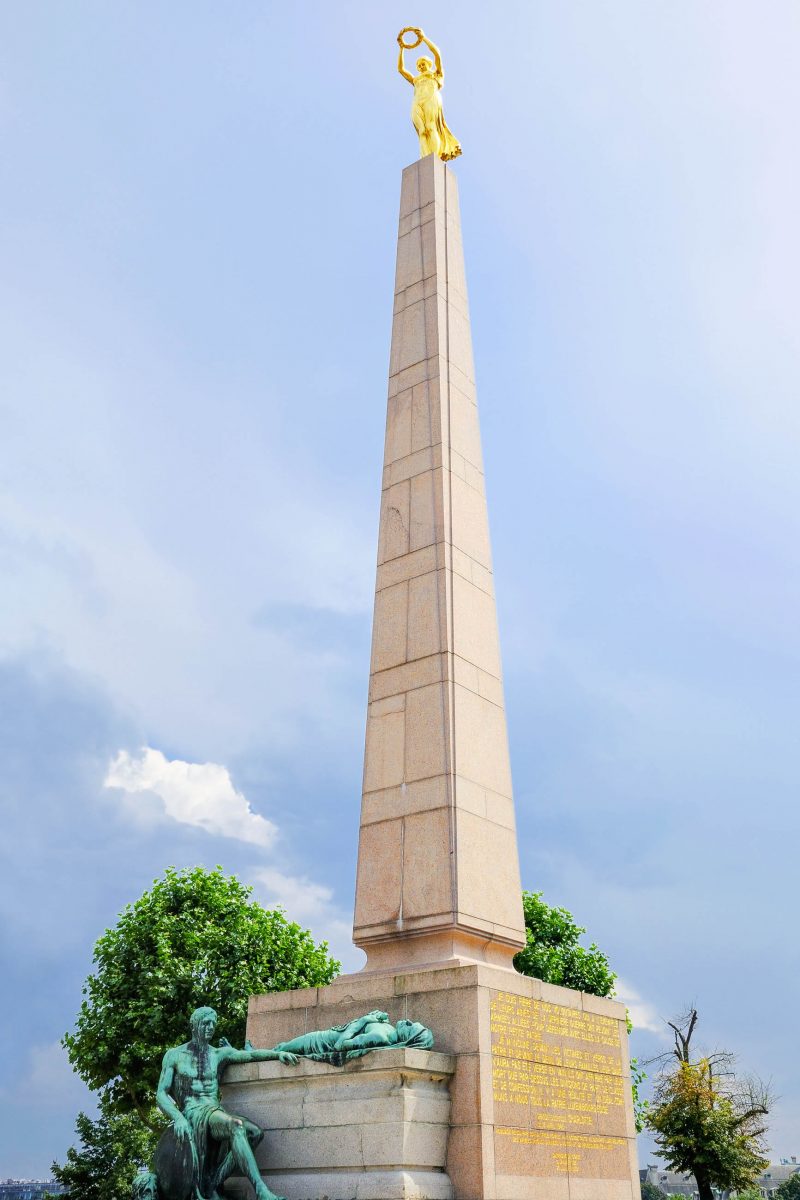
Die beiden Bronze-Statuen zu ihren Füßen verkörpern einen gefallenen Soldaten und einen weiteren, der um seinen Kameraden trauert. Die beiden Statuen stehen für die tausende tapferen Männer, die sich im Ersten Weltkrieg zum Dienst in Frankreich meldeten und nicht nach Hause zurückkehrten.
Mittlerweile ging die Gëlle Fra mit der Geschichte und gilt nun auch als Denkmal an die Opfer des Zweiten Weltkriegs und des Koreakrieges. Außerdem wird sie von der Luxemburger Bevölkerung als Symbol für Freiheit und Widerstand angesehen.
Sturz der Gëlle Fra im Zweiten Weltkrieg
Am 21. Oktober 1940 wurde die Gëlle Fra in Luxemburg Stadt von deutschen Besatzern von ihrem Sockel gestürzt. Einige hundert Personen wohnten dem Spektakel bei und demonstrierten lautstark gegen die Demontierung, sodass gleich 48 Personen von den Nationalsozialisten verhaftet wurden. Die Statue blieb fortan verschwunden.
Erst im Jahr 1980 tauchte die Gëlle Fra wieder auf. Sie wurde von zwei Beamten unter der Haupttribüne des Luxemburger Fußballstadions wieder gefunden und war in bemitleidenswertem Zustand. Der Fund wurde erst ein Jahr später in der Zeitung bekannt gegeben.
1984 war das Kunstwerk originalgetreu wieder vollendet, sodass die Statue bei der Expo 2010 in Shanghai den Eingang zum Luxemburg-Pavillion flankieren konnte. Am 23. Juni 1985 wurde die Gëlle Fra unter Beisein der luxemburgischen Regierung wieder eingeweiht.
Pont Adolphe
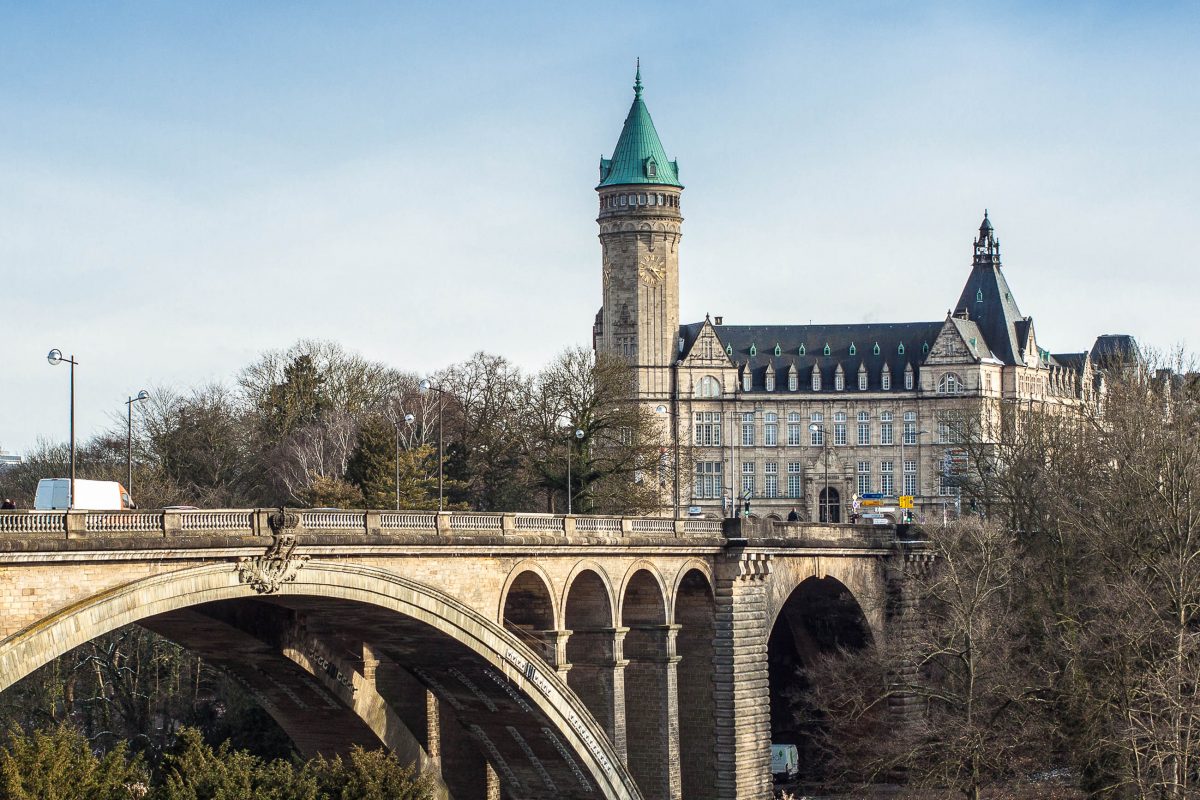
Vom Place de la Constitution hat man bereits einen guten Blick auf die auffällige Pont Adolphe, die Adolph-Brücke über dem Petruss-Fluss. Der burgähnliche Turm an der Südseite der Brücke gehört allerdings nicht zu einem Schloss, sondern zur städtischen Sparkasse. Der Turm ist gemeinsam mit der Brücke ein wunderbares Fotomotiv und im Inneren der Stadtsparkasse kann ein amüsantes Bankenmuseum besichtigt werden.
UNTERKÜNFTE & HOTELS: Luxemburg Stadt
Corniche und Kasematten von Luxemburg

Zurück über den F.D. Roosevelt-Boulevard, der am malerischen Petruss-Tal entlang führt, erreicht man über die Rue du St.-Esprit die Corniche von Luxemburg Stadt. Diese idyllische Promenade schlängelt sich neben den alten Wehrmauern am Ufer der Alzette entlang und bietet immer wieder herrliche Ausblicke auf den großzügig begrünten Stadtteil Grund. An ihrem Ende ist man wieder in der Rue Sigefroi angelangt.
Ebenfalls durch das gesamte Zentrum von Luxemburg Stadt ziehen sich die so genannten Kasematten. Dies sind Überreste der historischen Befestigungsanlagen aus dem 17. Jahrhundert. Heute noch zu besichtigen sind die Petruss-Kasematten und die Bock-Kasematten.
BILDER: Kasematten in Luxemburg Stadt
Fotogalerie: Kasematten in Luxemburg Stadt
Luxemburg Stadt war in den vergangenen Jahrhunderten eine hart umkämpfte Stadt und wurde mehrmals erobert. Im Lauf der Jahrzehnte wurde die Hauptstadt von Luxemburg zur bestbefestigten Stadt Europas mit mächtigen Bollwerken und ausgeklügelten Verteidigungssystemen.
Petruss- und Bock-Kasematten
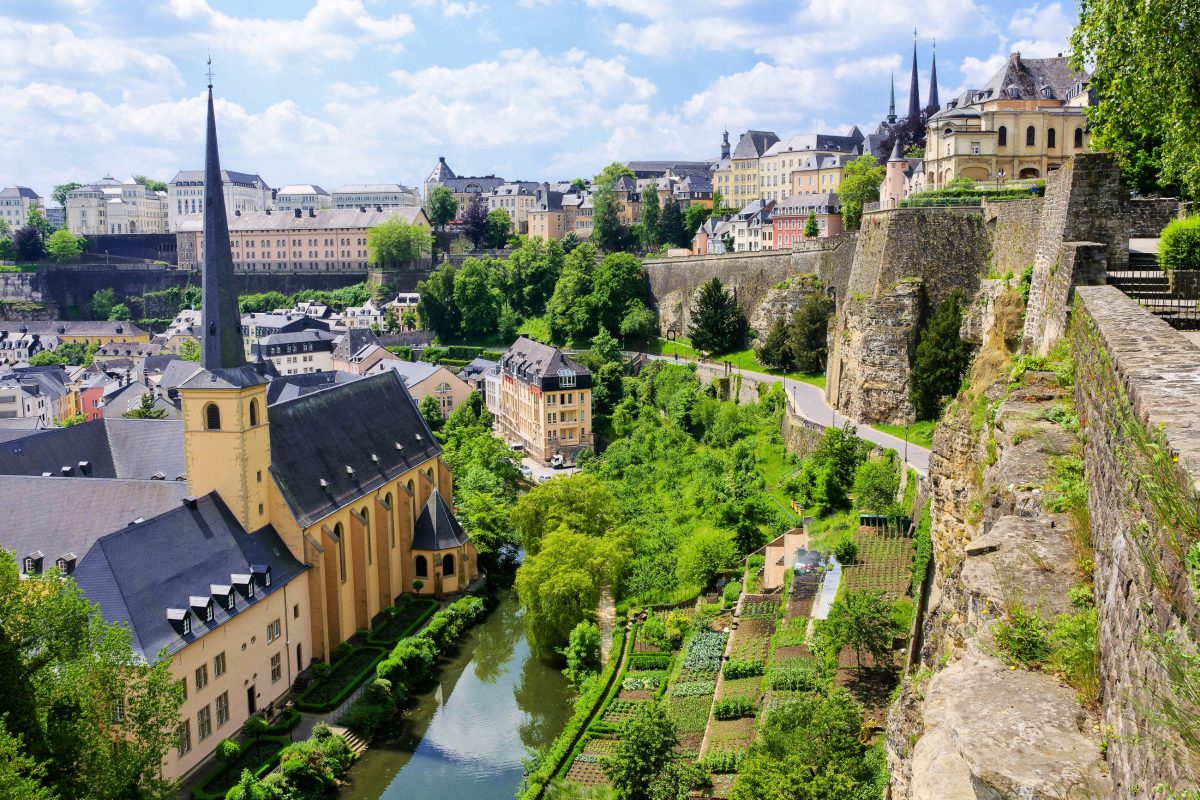
Die ersten Kasematten in der Altstadt von Luxemburg entstanden im Jahr 1644, als Luxemburg unter spanischer Herrschaft war. 40 Jahre später wurden sie durch Vauban, Frankreichs berühmtem Marschall und Festungsbauer, weiter ausgebaut. Unter seiner Aufsicht entstand das unterirdische Netz der Petruss-Kasematten. Diese wurden im Jahr 1903 gänzlich zugemauert, 30 Jahre später jedoch für die Öffentlichkeit wieder zugänglich gemacht.
Die Bock-Kasematten wurden Mitte des 18. Jahrhunderts von den Österreichern in den so genannten Bockfelsen gehauen, einem markanten Felsvorsprung über der Azette.
Gigantische Ausmaße der Kasematten von Luxemburg Stadt

Die Kasematten führten auf mehreren Ebenen kreuz und quer durch den Fels und hatten damals eine Gesamtlänge von 23km. Allein auf den 110m der Bock-Kasematten waren über 1.000 Soldaten und 50 Kanonen stationiert.
Einige der Stollen reichten bis 40m tief unter die Erde und beherbergten neben Geschützen auch Küchen, Schlachthöfe und Bäckereien, um im Fall einer Belagerung überleben zu können. Kein Wunder also, dass Luxemburg auch „Gibraltar des Nordens“ genannt wurde.
Beinahe-Zerstörung der Kasematten
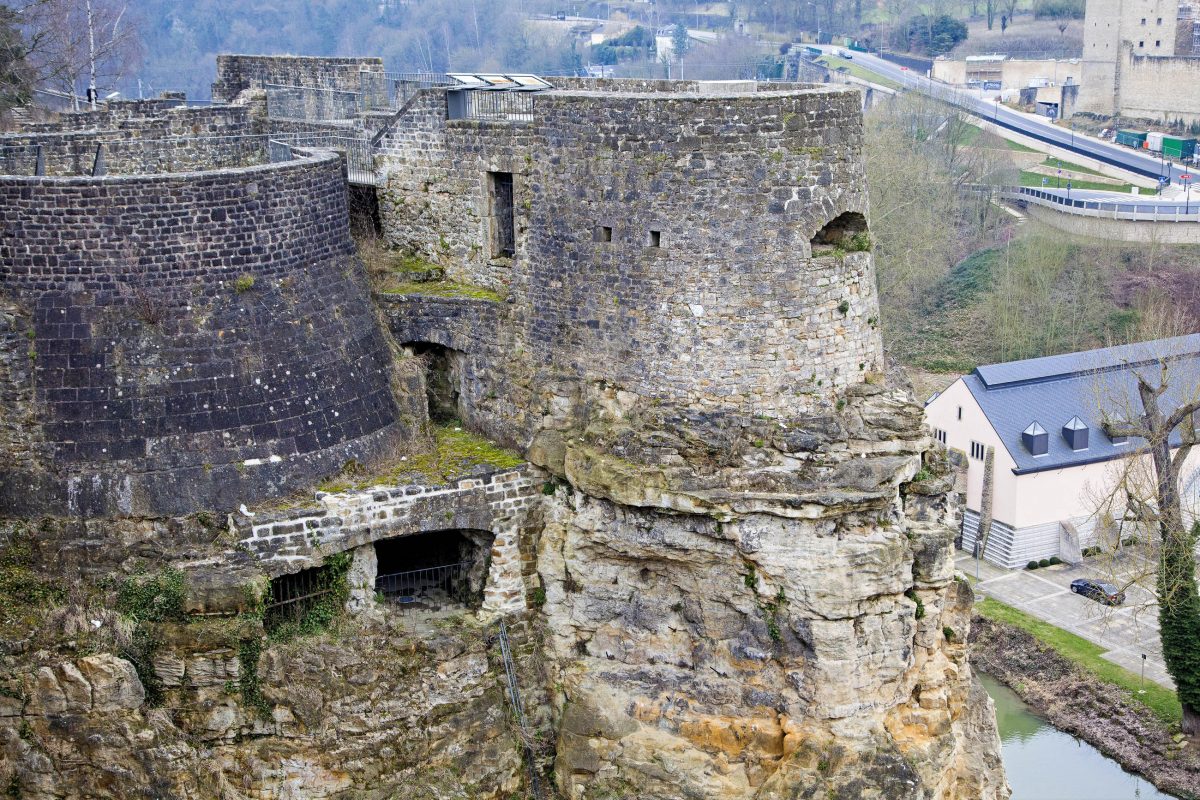
Im Jahr 1867 wurde jedoch in der Londoner Konferenz die Neutralität Luxemburgs beschlossen und alle Verteidigungseinrichtungen mussten vernichtet werden. Neben den 24 Forts, die Luxemburg befestigten, fielen auch die Kasematten der Sprengung zum Opfer.
Von den 23km blieben jedoch 17 bis heute erhalten, da sonst das Fundament der gesamten Altstadt von Luxemburg in Gefahr gebracht worden wäre. Die Schießscharten und Eingänge wurden lediglich verschlossen. Trotzdem besitzen noch immer einige Häuser im Keller Zugänge zu den Kasematten und im Stadtarchiv sind noch über 1.000 Karten des unterirdischen Kasematten-Netzwerks zu finden.
In den beiden Weltkriegen leisteten die Kasematten der Bevölkerung der Stadt Luxemburg als Schutzbunker gute Dienste. 35.000 Menschen entgingen so den feindlichen Bombenangriffen.
Besichtigung der Kasematten
Heute dienen die Kasematten der Stadt nach wie vor, jedoch auf friedliche Weise als eine der Top Sehenswürdigkeiten Luxemburgs. Die Bock-Kasematten und die Petruss-Kasematten können beide im Zuge von Führungen besichtigt werden. Jährlich besuchen an die 100.000 Touristen das Vermächtnis der damaligen Feldherren.
BILDER: Altstadt von Luxemburg Stadt
Fotogalerie: Altstadt von Luxemburg Stadt
Weiterführende Links:
Offizielle Tourismus-Website von Luxemburg-Stadt
Preise und Öffnungszeiten des Nationalmuseums von Luxemburg
Offizielle Website des Großherzoglichen Palastes
Preise und Öffnungszeiten der Bock-Kasematten
Preise und Öffnungszeiten der Petruss-Kasematten

